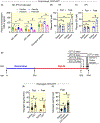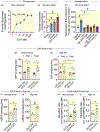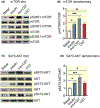Catestatin induces glycogenesis by stimulating the phosphoinositide 3-kinase-AKT pathway
- PMID: 34985191
- PMCID: PMC10754386
- DOI: 10.1111/apha.13775
Catestatin induces glycogenesis by stimulating the phosphoinositide 3-kinase-AKT pathway
Abstract
Aim: Defects in hepatic glycogen synthesis contribute to post-prandial hyperglycaemia in type 2 diabetic patients. Chromogranin A (CgA) peptide Catestatin (CST: hCgA352-372 ) improves glucose tolerance in insulin-resistant mice. Here, we seek to determine whether CST induces hepatic glycogen synthesis.
Methods: We determined liver glycogen, glucose-6-phosphate (G6P), uridine diphosphate glucose (UDPG) and glycogen synthase (GYS2) activities; plasma insulin, glucagon, noradrenaline and adrenaline levels in wild-type (WT) as well as in CST knockout (CST-KO) mice; glycogen synthesis and glycogenolysis in primary hepatocytes. We also analysed phosphorylation signals of insulin receptor (IR), insulin receptor substrate-1 (IRS-1), phosphatidylinositol-dependent kinase-1 (PDK-1), GYS2, glycogen synthase kinase-3β (GSK-3β), AKT (a kinase in AKR mouse that produces Thymoma)/PKB (protein kinase B) and mammalian/mechanistic target of rapamycin (mTOR) by immunoblotting.
Results: CST stimulated glycogen accumulation in fed and fasted liver and in primary hepatocytes. CST reduced plasma noradrenaline and adrenaline levels. CST also directly stimulated glycogenesis and inhibited noradrenaline and adrenaline-induced glycogenolysis in hepatocytes. In addition, CST elevated the levels of UDPG and increased GYS2 activity. CST-KO mice had decreased liver glycogen that was restored by treatment with CST, reinforcing the crucial role of CST in hepatic glycogenesis. CST improved insulin signals downstream of IR and IRS-1 by enhancing phospho-AKT signals through the stimulation of PDK-1 and mTORC2 (mTOR Complex 2, rapamycin-insensitive complex) activities.
Conclusions: CST directly promotes the glycogenic pathway by (a) reducing glucose production, (b) increasing glycogen synthesis from UDPG, (c) reducing glycogenolysis and (d) enhancing downstream insulin signalling.
Keywords: catestatin; glucose-6-phosphate; glycogen; glycogen synthase; hyperglycaemia; phospho-AKT.
© 2022 Scandinavian Physiological Society. Published by John Wiley & Sons Ltd.
Conflict of interest statement
CONFLICTS OF INTEREST
The authors have declared no conflict of interest.
Figures










Comment in
-
Hepatic glucose production and storage as a potential strategy for type 2 diabetes treatment - The effect of catestatin - "just another new kid in town?".Acta Physiol (Oxf). 2022 May;235(1):e13808. doi: 10.1111/apha.13808. Epub 2022 Mar 4. Acta Physiol (Oxf). 2022. PMID: 35224867 No abstract available.
Similar articles
-
Adrenaline potentiates insulin-stimulated PKB activation in the rat fast-twitch epitrochlearis muscle without affecting IRS-1-associated PI 3-kinase activity.Pflugers Arch. 2008 Aug;456(5):969-78. doi: 10.1007/s00424-008-0471-z. Epub 2008 Feb 26. Pflugers Arch. 2008. PMID: 18299886
-
Irisin inhibits hepatic gluconeogenesis and increases glycogen synthesis via the PI3K/Akt pathway in type 2 diabetic mice and hepatocytes.Clin Sci (Lond). 2015 Nov;129(10):839-50. doi: 10.1042/CS20150009. Epub 2015 Jul 13. Clin Sci (Lond). 2015. PMID: 26201094
-
Resistin disrupts glycogen synthesis under high insulin and high glucose levels by down-regulating the hepatic levels of GSK3β.Gene. 2013 Oct 15;529(1):50-6. doi: 10.1016/j.gene.2013.06.085. Epub 2013 Jul 13. Gene. 2013. PMID: 23860320 Free PMC article.
-
Putative regulation of macrophage-mediated inflammation by catestatin.Trends Immunol. 2022 Jan;43(1):41-50. doi: 10.1016/j.it.2021.11.002. Epub 2021 Nov 27. Trends Immunol. 2022. PMID: 34844850 Free PMC article. Review.
-
Catestatin: a multifunctional peptide from chromogranin A.Regul Pept. 2010 Jun 8;162(1-3):33-43. doi: 10.1016/j.regpep.2010.01.006. Epub 2010 Jan 28. Regul Pept. 2010. PMID: 20116404 Free PMC article. Review.
Cited by
-
Low catestatin as a risk factor for cardiovascular disease - assessment in patients with adrenal incidentalomas.Front Endocrinol (Lausanne). 2023 Jul 14;14:1198911. doi: 10.3389/fendo.2023.1198911. eCollection 2023. Front Endocrinol (Lausanne). 2023. PMID: 37522122 Free PMC article.
-
Revving the engine: PKB/AKT as a key regulator of cellular glucose metabolism.Front Physiol. 2024 Jan 8;14:1320964. doi: 10.3389/fphys.2023.1320964. eCollection 2023. Front Physiol. 2024. PMID: 38264327 Free PMC article. Review.
-
Role of Catestatin in the Cardiovascular System and Metabolic Disorders.Front Cardiovasc Med. 2022 May 19;9:909480. doi: 10.3389/fcvm.2022.909480. eCollection 2022. Front Cardiovasc Med. 2022. PMID: 35665253 Free PMC article. Review.
-
Prognostic Value of Plasma Catestatin Concentration in Patients with Heart Failure with Reduced Ejection Fraction in Two-Year Follow-Up.J Clin Med. 2023 Jun 22;12(13):4208. doi: 10.3390/jcm12134208. J Clin Med. 2023. PMID: 37445245 Free PMC article.
-
The Role of Catestatin in Preeclampsia.Int J Mol Sci. 2024 Feb 20;25(5):2461. doi: 10.3390/ijms25052461. Int J Mol Sci. 2024. PMID: 38473713 Free PMC article. Review.
References
-
- Martin BC, Warram JH, Krolewski AS, Bergman RN, Soeldner JS, Kahn CR. Role of glucose and insulin resistance in development of type 2 diabetes mellitus: results of a 25-year follow-up study. Lancet. 1992;340(8825):925–929. - PubMed
-
- Kahn SE, Hull RL, Utzschneider KM. Mechanisms linking obesity to insulin resistance and type 2 diabetes. Nature. 2006;444(7121):840–846. - PubMed
-
- Shoelson SE, Herrero L, Naaz A. Obesity, inflammation, and insulin resistance. Gastroenterology. 2007;132(6):2169–2180. - PubMed
-
- DeFronzo RA, Ferrannini E, Groop L, et al. Type 2 diabetes mellitus. Nat Rev Dis Primers. 2015;1:15019. - PubMed
-
- Menke A, Casagrande S, Geiss L, Cowie CC. Prevalence of and trends in diabetes among adults in the United States, 1988–2012. JAMA. 2015;314(10):1021–1029. - PubMed
Publication types
MeSH terms
Substances
Grants and funding
LinkOut - more resources
Full Text Sources
Research Materials
Miscellaneous

